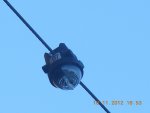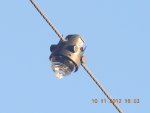KentAT
Senior Member
- Location
- Northeastern PA
The neighbor of the plant I work at tells me she saw a steady flashing yellow light in the area of where our plant's 12.6KV aerial service attaches to the POCO at the highway. Since it was foggy, it flashed like a bright beacon and lit the area up.
I looked up at the lines today, and I saw that each phase has a device attached on it. They are little roundish things, one per phase, about 10-15 feet down our lines away from the tap. They don't appear to be connected to anything.
My coworker also said he also saw it flashing that day.
Any ideas?
I will post a pic tomorrow.
Kent
I looked up at the lines today, and I saw that each phase has a device attached on it. They are little roundish things, one per phase, about 10-15 feet down our lines away from the tap. They don't appear to be connected to anything.
My coworker also said he also saw it flashing that day.
Any ideas?
I will post a pic tomorrow.
Kent



